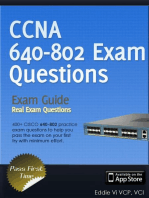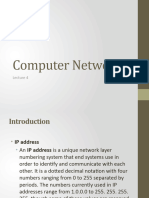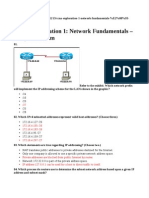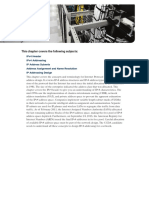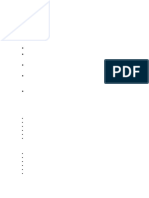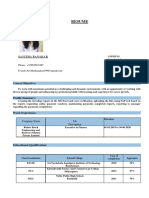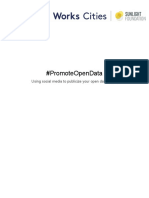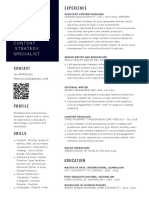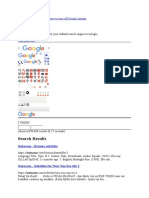Chap Assignment
Chap Assignment
Uploaded by
lazer155Copyright:
Available Formats
Chap Assignment
Chap Assignment
Uploaded by
lazer155Copyright
Available Formats
Share this document
Did you find this document useful?
Is this content inappropriate?
Copyright:
Available Formats
Chap Assignment
Chap Assignment
Uploaded by
lazer155Copyright:
Available Formats
Michael S Murphy | NET 125
Chapter 6: IPv4 Addresses
Concept Questions
1. What is another name for digital logic? Binary patterns 2. What is the format used for IP addresses called? Dotted decimal 3. What is another way to refer to 1 byte or 8 bits? The bytes are called an octet, because each of the decimal numbers represents 1 byte, or 8 bits. 4. What does IPv4 provide for packets that carry data? IPv4 have two parts: the network portion and host portion.
Binary-to-Decimal Conversion Exercise
Convert the following 32-bit binary number into an IP address, keeping in mind the following: Divide the 32 bits into four octets. Convert each octet to decimal.
Add a dot between each decimal. Binary number: 10101100000100000000010000010100 IP address: 172.16.4.20
Decimal-to-Binary Conversion Exercise
Convert the following IP address into 32-bit binary number. IP address: 172.16.5.20 Binary number: 10101100000100000000010100010100
Addresses for Different Purposes
Within the address range of each IPv4 network are three types of addresses: Network addresses Broadcast addresses
Host addresses
Vocabulary Exercise: Matching
Address Type A. Network address B. Broadcast address C. Host address Communication Type A. Unicast B. Broadcast C. Multicast Definition B. A special address used to send data to all hosts in the network C. An address assigned to an end device in the network A. The address by which we refer to the network Definition B. The process of sending a packet from one host to all hosts in the network C. The process of sending a packet from one host to a selected group of hosts A. The process of sending a packet from one host to an individual host
Vocabulary: Completion
1. Expressed in dotted-decimal format, the IPv4 address range is 0.0.0.0 to 255.255.255.255. 2. One major block of addresses reserved for special purposes is the IPv4 experimental address range 244.0.0.0 to 239.255.255.255. Currently, these addresses are listed as multicast groups. 3. Another major block of addresses reserved for special purposes in the IPv4 multicast address range 224.0.0.0 to 239.255.255.255. 4. The globally scoped multicast addresses are 224.01.0 to 238.255.255.255.
Concept Questions
1. How do you know how many bits represent the network portion and how many bits represent the host portion? 2. What is the prefix length? The number of bits in the address that gives the network portion 3. What are the private address blocks? They are set aside for use in private networks. 10.0.0.0/8 (10.0.0.0 to 10.255.255.255) 172.16.00/12 (172.16.0.0 to 172.31.255.255)
192.168.0.0/16 (192.168.0.0 to 192.168.255.255)
4. Which addresses in a network cannot be assigned to hosts? Special Unicast IPv4 5. What is the reserved block for default routing? It is a catch all route to route packets, and it is 0.0.0.0. 6. What is the loopback address, and what block is reserved for loopback? It is a special address that hosts use to direct traffic to themselves, and it is 127.0.0.1 to block 127.0.0.0/8 (127.0.0.0 to 127.255.255.255. 7. What block of addresses is designated link-local? It is 169.254.0.0/16 to block (169.254.0.0 to 169.254.255.255). 8. What block of addresses is designated TEST-NET? It is set aside for teaching and learning and learning purposes, and it blocks 192.0.2.0/24 (192.0.2.0 to 192.0.2.255). 9. Define classless addressing. Classless addressing is the system that is currently in use.
Concept Questions
1. Describe the pros and cons of static addressing. They are useful for printers, servers, and other networking devices that need to be accessible to clients on the network, and they have problems caused if that address changed. 2. Describe the pros and cons of using DHCP for addressing. DHCP enables the automatic assignment of addressing information sucha as IP address, subnet mask, default gateway, and other configuration. 3. List four types of device that work best using static IP addresses. PCs, IP phones, printers, and PDAs 4. What is the primary focus of each of the three tiers of ISPs? Tier 1: reliability and speed Tier 2: slower Internet access Tier 3: connectivity and support 5. List some improvements that IPv6 will provide.
Binary Matching Exercise
Binary Number a. 00000000 b. 10000000 c. 11000000 d. 11100000 e. 11110000 f. 11111000 g. 11111100 h. 11111110 i. 11111111 Concept Questions 1. How is a subnet mask created? p207 2. Why do routers use ANDing?
Numeric Value c. 192 d. 224 f. 248 e. 240 a. 0 i. 255 g. 252 h. 254 b. 128
Routers use ANDing to determine an acceptable route for an acceptable route for an incoming packet. 3. How does ANDing help an originating host? A logical AND is also performed by an originating host between the destination address of the packet and the subnet mask of the host. 4. If the routers and end devices calculate these processes without your intervention, why do you need to learn how to AND? You need to understand the operation of the network devices.
Concept Questions
1. What is the formula to calculate the number of subnets? p211-227 2. What are the two most useful tools in designing a network? 3. Using VLSM makes it easier to group networks around what commonalities?
Multiple-Choice Questions
1. Why would you use a VLSM chart? a. This method helps prevent assigning addresses that have already been allocated. b. This method lets you assign addresses that have already been allocated.
c. This method prevents addresses from being allocated. d. Using a chart makes calculating VLSM easier. 2. For what is VLSM an acronym? a. Very Long String of Marbles b. Variant Language Superior Model c. Variable-Length Subsidiary Mode d. Variable-Length Subnet Mask 3. What utility attempts to trace the path that a packet takes through the network? a. ping b. SNMP c. traceroute d. Cpnfigmaker
Testing the Network Layer Concept Questions
1. How does ping work? Be as specific as you can. ping is a utility for testing IP connectivity between hosts, and it sends out requests for responses from a specified host address. 2. What does a response from 127.0.0.1 indicate? It indicates that IP is properly installed on the host. 3. Assume that you ping your gateway. If the gateway does not respond, but another host does, what sort of problem could this indicate? It could indicate a problem with the routers interface serving as the gateway. 4. Why is ping not always the most reliable test for connectivity on a network? p230 5. What does traceroute do? Traceroute (tracert) is a utility that allow you to observe the path between these hosts. 6. What does RTT stand for? Round-trip Time 7. What does TTL stand for? Time to Live 8. Name the different ICMP message types. Host confirmation
Unreachable destination or service Time exceeded Route redirection Source Quench
Vocabulary Exercise: Completion 1. What do the first four Destination Unreachable codes mean? 0 = net unreachable 1 = host unreachable 2 = protocol unreachable 3 = port unreachable 2. If a router does not have enough buffer space to receive incoming packets, the router discards these packets. A destination host may also send a Source Quench message if datagrams arrive too fast to be processed.
You might also like
- Network Essentials 2.0 FULL Answers 2021Document299 pagesNetwork Essentials 2.0 FULL Answers 2021mika100% (2)
- Subnetting LabDocument5 pagesSubnetting LabBruno BandinaNo ratings yet
- Inter-Networks: RoutersDocument6 pagesInter-Networks: RoutersJade BARTONNo ratings yet
- Interview Questions and Answers For Freshers - TCP - IP PDFDocument8 pagesInterview Questions and Answers For Freshers - TCP - IP PDFNishant RajNo ratings yet
- CN Lab 3Document12 pagesCN Lab 3talha khalidNo ratings yet
- SubnettingDocument18 pagesSubnettingOpeyemi OsanaiyeNo ratings yet
- CH5Document58 pagesCH5digafeeyuel0% (1)
- Ip Addressing and Subnetting 1Document39 pagesIp Addressing and Subnetting 1Abraham ThompsonNo ratings yet
- ACN UNIT 1_186_N3Document19 pagesACN UNIT 1_186_N3186Shraddha Bonde N1No ratings yet
- CN Unit 2Document49 pagesCN Unit 2Prakhar MishraNo ratings yet
- Salesian Polytechnical University Systems Engineering: Networks IiDocument8 pagesSalesian Polytechnical University Systems Engineering: Networks Iisony_w200No ratings yet
- IPV4 and Subnetting StrategyDocument39 pagesIPV4 and Subnetting StrategyrolandsabitNo ratings yet
- IP AddressingDocument6 pagesIP AddressingLawrence RolluquiNo ratings yet
- Unit 3Document22 pagesUnit 3Arthi AnnamallaNo ratings yet
- Data Communication and Networking IP Addressing Sub NetworksDocument4 pagesData Communication and Networking IP Addressing Sub NetworksNelumNo ratings yet
- Ip Addressing and SubnettingDocument38 pagesIp Addressing and SubnettingHurjay NaguitNo ratings yet
- 98-366 MVA Slides Lesson 4Document31 pages98-366 MVA Slides Lesson 4cvigaNo ratings yet
- Lecture 4Document37 pagesLecture 4sohail75kotbNo ratings yet
- Group Assignment of AbdiDocument6 pagesGroup Assignment of AbdiEyosias BelachewNo ratings yet
- CCNA 1 Chapter 6 V4.0 AnswersDocument8 pagesCCNA 1 Chapter 6 V4.0 AnswersAbdullah Al HawajNo ratings yet
- Networks2 OdtDocument8 pagesNetworks2 Odtumang goelNo ratings yet
- CISCO CCNA1 Chapter 6 Ethiopian Digital LibraryDocument5 pagesCISCO CCNA1 Chapter 6 Ethiopian Digital LibraryOz GNo ratings yet
- ACN Solved Que 2 Summer 2023Document6 pagesACN Solved Que 2 Summer 2023papratiksha377No ratings yet
- Cisco CCNA Discovery 2 Hoofdstuk 4Document22 pagesCisco CCNA Discovery 2 Hoofdstuk 4LaPingvinoNo ratings yet
- Ip Addressing and SubnettingDocument40 pagesIp Addressing and SubnettingArjun AjuNo ratings yet
- NETW202 Lab/Assignment Worth 55 Points WK 2 Lab Answer SheetDocument9 pagesNETW202 Lab/Assignment Worth 55 Points WK 2 Lab Answer SheetOmar TorresNo ratings yet
- ReS1.08 IP ADDRESSING ARCHITECTUREDocument14 pagesReS1.08 IP ADDRESSING ARCHITECTUREHisham MohamedNo ratings yet
- Answers To Tutorial Sheets 1 and 2Document11 pagesAnswers To Tutorial Sheets 1 and 2bezahtracyNo ratings yet
- CCNA E1 Final 5-8 Exam 1Document71 pagesCCNA E1 Final 5-8 Exam 1antropolicNo ratings yet
- Networks2 PDFDocument8 pagesNetworks2 PDFumang goelNo ratings yet
- IP AddressingDocument19 pagesIP Addressingvishalpalv43004No ratings yet
- Acn Imp Q&aDocument72 pagesAcn Imp Q&acasexi3151No ratings yet
- CCNA1 Chapter 6Document6 pagesCCNA1 Chapter 6mubaswirNo ratings yet
- This Chapter Covers The Following SubjectsDocument46 pagesThis Chapter Covers The Following SubjectsAnh TieuNo ratings yet
- Ch02 Network AdministerationsDocument56 pagesCh02 Network Administerationsadaneasefa969No ratings yet
- IP AddressDocument20 pagesIP AddressNayr ZdahbNo ratings yet
- Chapter 6 AnswersDocument13 pagesChapter 6 Answerslektor_hektorNo ratings yet
- CybeOps QuestionsDocument21 pagesCybeOps QuestionsJayz JoeNo ratings yet
- CCNA1 Cap6Document6 pagesCCNA1 Cap6giancarlo46No ratings yet
- ACN Chapter 1Document22 pagesACN Chapter 1knights09876543No ratings yet
- CN - Chapter 5 - The Network Layer - Class 3, 4Document24 pagesCN - Chapter 5 - The Network Layer - Class 3, 4himanshuajaypandeyNo ratings yet
- IPAddressDocument33 pagesIPAddressBrij ChaudharyNo ratings yet
- Chapter 6 TestDocument9 pagesChapter 6 Testwewoka748842002No ratings yet
- Lecture 9 Nat PatDocument21 pagesLecture 9 Nat PatTanvir ChowdhuryNo ratings yet
- Netcom Module IVDocument53 pagesNetcom Module IVMC JERID C. BATUNGBAKALNo ratings yet
- Unit 5 IPv6Document11 pagesUnit 5 IPv6Dudzayi KasiyoNo ratings yet
- Data Comm Part 2.ppt NewDocument48 pagesData Comm Part 2.ppt Newmuhabamohamed21No ratings yet
- Abhishek Pal - Project Report 2012Document34 pagesAbhishek Pal - Project Report 2012Ankit GuptaNo ratings yet
- 04 - TCPIP ProtocolDocument74 pages04 - TCPIP ProtocolTuan LeNo ratings yet
- Acn Chap 1Document28 pagesAcn Chap 1Noor alam ShaikhNo ratings yet
- Take Assessment - Enetwork Chapter 6 - Ccna Exploration: Network Fundamentals (Version 4.0) - Answers - 2012 - 2013Document7 pagesTake Assessment - Enetwork Chapter 6 - Ccna Exploration: Network Fundamentals (Version 4.0) - Answers - 2012 - 2013Alexander Henao GutierrezNo ratings yet
- Lab 06Document14 pagesLab 06nomanbsitNo ratings yet
- IP Addressing: (Ipv4 Addresses)Document35 pagesIP Addressing: (Ipv4 Addresses)Kumail RazaNo ratings yet
- 327 17CS46 Module 5Document34 pages327 17CS46 Module 5Bảo ChâuNo ratings yet
- CCNA Exam NotesDocument26 pagesCCNA Exam NotesDua ArsalanNo ratings yet
- DGTL Tscsec 507Document31 pagesDGTL Tscsec 507abaheabaheNo ratings yet
- Ellis and Davey's Classification of Tooth FractureDocument1 pageEllis and Davey's Classification of Tooth FractureArniza Dental CareNo ratings yet
- F5 Configuration - HTTPS WSS OffloadingDocument28 pagesF5 Configuration - HTTPS WSS Offloadingo0000oNo ratings yet
- 101 New Features in SharePoint 2013Document27 pages101 New Features in SharePoint 2013forbiswajitNo ratings yet
- Cyber ReportDocument2 pagesCyber ReportIcy RosianaNo ratings yet
- Certified Ethical Hacker Ceh Crash CourseDocument2 pagesCertified Ethical Hacker Ceh Crash CourseJory MontoyaNo ratings yet
- Beyond Books Rental (BBR)Document14 pagesBeyond Books Rental (BBR)Diya SoniNo ratings yet
- AZ 104T00A ENU ChangeLogDocument10 pagesAZ 104T00A ENU ChangeLogBrice TOSSAVINo ratings yet
- Potential Security Threats To Your Computer SystemsDocument8 pagesPotential Security Threats To Your Computer SystemsBappy HossainNo ratings yet
- Savitha Banakar CVDocument2 pagesSavitha Banakar CVuiuariibNo ratings yet
- Cybersecurity in The Age of MobilityDocument20 pagesCybersecurity in The Age of MobilityMirena ChardakovaNo ratings yet
- Topic: Firewall Implementation Using Cisco Packet Tracer: Network and Information SecurityDocument9 pagesTopic: Firewall Implementation Using Cisco Packet Tracer: Network and Information Securityvsslondhe13No ratings yet
- CCNP 300 410 ENARSI Networktut 8 2022Document330 pagesCCNP 300 410 ENARSI Networktut 8 2022Duy Nguyễn ĐứcNo ratings yet
- 210 255 Secops v2Document5 pages210 255 Secops v2vjjmirasNo ratings yet
- #PromoteOpenData: How Cities Can Use Social Media To Publicize Open Data PolicyDocument14 pages#PromoteOpenData: How Cities Can Use Social Media To Publicize Open Data PolicySunlight FoundationNo ratings yet
- Guia de Practica Pt31 $ Xyz#Document21 pagesGuia de Practica Pt31 $ Xyz#Tom LunaNo ratings yet
- Pragya Sood CV UpdatedDocument1 pagePragya Sood CV UpdatedSiddhant BudhirajaNo ratings yet
- SAP Cloud Platform Connectivity - ServiceDocument458 pagesSAP Cloud Platform Connectivity - ServiceAidonNo ratings yet
- Checkpoint Firewall Administration Training Part2Document29 pagesCheckpoint Firewall Administration Training Part2ajay1989sNo ratings yet
- Malaysia Data Security Governance Reference BookDocument49 pagesMalaysia Data Security Governance Reference BookgogetkaraNo ratings yet
- EFDT Learning PlanDocument2 pagesEFDT Learning Planclaire CayangcangNo ratings yet
- Q1. What Is Proxy Server?Document5 pagesQ1. What Is Proxy Server?Sasmita SasmitaNo ratings yet
- Test Cases SPPU ExaminationDocument9 pagesTest Cases SPPU ExaminationAjay KadamNo ratings yet
- How To Get Paid To Travel The WorldDocument2 pagesHow To Get Paid To Travel The WorldMahmoud Safaa0% (1)
- Etech WK 1 Mar 7-12Document46 pagesEtech WK 1 Mar 7-12Adrian MagtotoNo ratings yet
- Disruptive Innovation, McKinsey-Style - McKinsey & CompanyDocument1 pageDisruptive Innovation, McKinsey-Style - McKinsey & CompanyYulia HartonoNo ratings yet
- Sectigo CPS v5 3 4-1Document129 pagesSectigo CPS v5 3 4-1MK ULTRANo ratings yet
- Whatsapp Structured Message Templates For BusinessDocument4 pagesWhatsapp Structured Message Templates For BusinessJumper AI ChatbotNo ratings yet
- 5G Voice Services Implementation Options - TechplayonDocument4 pages5G Voice Services Implementation Options - TechplayonShuvojit ChowdhuryNo ratings yet
- Screen Reader UsersDocument3 pagesScreen Reader UsersandreNo ratings yet

